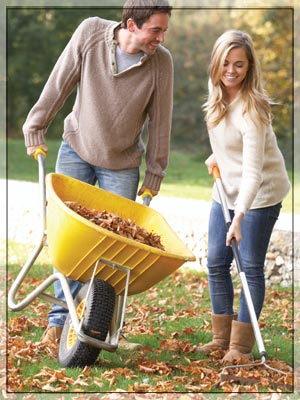Avoiding Common Autumn Injuries

As the leaves begin to change color, the breeze turns cooler and school is back in session, you know that autumn is here. While the arrival of this new season can be exciting, for many of us it’s time for additional yardwork duties. Cleaning the gutters, fertilizing the lawn, packing up the summer furniture – and raking leaves!
When your yard becomes covered in colorful fallen leaves, you may spend the better part of a couple October weekends raking and cleaning up the yard. Although yardwork is often a necessity, it’s important to be careful and plan appropriately to avoid joining the nearly 40,000 Americans who suffer injuries from raking each year. If you don’t want to miss out on your favorite fall activities due to preventable injury and pain, we offer advice to help keep you safe while raking this season.
Why Does Raking Make Us So Prone to Injury?
Many injuries occur when our muscles become overworked and fatigued. When the primary muscles used during an activity become overtired, we compromise our posture, which puts additional strain on other muscle groups in order to continue working. Because raking is a repetitive task, muscles that are not used to seeing strenuous work can quickly weaken. Many of the patients we treat tell us that they rushed through raking because they wanted to get the job done fast. When it’s Sunday afternoon and you only have an hour until the big game starts, you tend to skip stretching, rake with urgency and ignore your posture. Rushing to finish a yardwork task often ends in elbow, shoulder, neck and low back injuries.
Preparing to Rake
Most of us dread inevitable fall yardwork, so it’s natural to have the mentality that the sooner you finish the better. However, it’s important to first take time to prepare your body for the task at hand. Our physical therapists recommend warming up your muscles prior to taking on the task of raking. This could include taking in the autumn scenery with a brisk walk to get your heart rate pumping and then performing stretches that target the muscles in the neck, shoulder, forearm and low back that are more commonly overworked while raking.
Cautions During Raking
While you’re raking, be sure to maintain good posture. We understand that you’re likely not paying attention to your posture when all you want to do is finish the task, but try to be conscious of how you position yourself with the rake. Stand tall and move with care. Do not aggressively twist through the spine and remember that you can rely on other parts of the body for strength, like your legs, to avoid a potential back injury. Many patients we treat for raking injuries tried to be “weekend warriors” by working for hours straight in order to join their families for a day at the pumpkin patch. However, taking frequent breaks will keep you from feeling regretful later when carving pumpkins with the kids.
Benefits of PT Treatment for Overuse
If you suffer an injury doing yardwork, the single most important benefit of choosing physical therapy treatment first is time. If you instead choose to see your primary care physician first, you’ll likely be told to take pain relievers for a week and call back if the pain hasn’t gotten better on its own. Should your pain persist, only then would you be referred to a physical therapist after experiencing discomfort for a week or more in some cases. There is an alternative! Through a program called Direct Access, you can save time and money by visiting a physical therapist first, without a referral from your doctor. One of our experienced team members can diagnose your injury and start you on a swift plan to recovery. Avoid prolonging your pain and schedule an appointment with us at its first sign!
What to Expect at Your Physical Therapy Appointment
When you’ve suffered an injury due to raking, there are several approaches to treatment that our physical therapists may try with you. Determining the best course of treatment depends on the individual patient and is often tailored based on the location and severity of the injury and your medical history. In-office treatments may include:
- Deep Friction Massage: This is a manual therapy technique used to reverse muscle and soft tissue restriction. Deep pressure is applied in a transverse direction across the injured tissue to aid in the healing and reduce pain.
- Integrative Dry Needling: This method helps with muscle strain and injury, pain management, flexibility, tissue restoration and faster healing. The needles used are similar to acupuncture, but the placement is based on trigger points in the body.
- Mulligan Therapy: These techniques are highly specialized and hands-on. Mulligan Therapy is a manual intervention on a joint to restore proper joint position to decrease pain and improve a patient’s range of motion. In the case of a raking injury, it would be best used for positional faults within the neck and low back, as well as the elbow and shoulder.
Your physical therapist may also teach you strengthening exercises to do at home to reduce your pain and help prevent future injuries.
Contact us today to learn more about the treatment of common fall overuse injuries.

